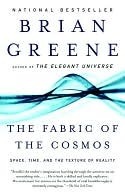More on this book
Community
Kindle Notes & Highlights
by
Brian Greene
Started reading
October 4, 2024
The universe, according to quantum mechanics, is not etched into the present; the universe, according to quantum mechanics, participates in a game of chance.
Conventional theory claims, and experiments confirm, that these particles combine in various ways to produce protons, neutrons, and the wide variety of atoms and molecules making up everything we’ve ever encountered. Superstring theory tells a different story. It does not deny the key role played by electrons, quarks, and the other particle species revealed by experiment, but it does claim that these particles are not dots. Instead, according to superstring theory, every particle is composed of a tiny filament of energy, some hundred billion billion times smaller than a single atomic nucleus
...more
All species of particles are unified in superstring theory since each arises from a different vibrational pattern executed by the same underlying entity.
when I read Feynman’s description of a rose—in which he explained how he could experience the fragrance and beauty of the flower as fully as anyone, but how his knowledge of physics enriched the experience enormously because he could also take in the wonder and magnificence of the underlying molecular, atomic, and subatomic processes—I was hooked for good.
I wanted what Feynman described: to assess life and to experience the universe on all possible levels, not just those that happened to be accessible to our frail human senses. The search for the deepest understanding of the cosmos became my lifeblood.
Newton—a man so driven by the pursuit of truth that he once shoved a blunt needle between his eye and the socket bone to study ocular anatomy and, later in life as Master of the Mint, meted out the harshest of punishments to counterfeiters, sending more than a hundred to the gallows—had no tolerance for false or incomplete reasoning.
An object is truly at rest when it is at rest with respect to absolute space. An object is truly moving when it is moving with respect to absolute space. And, most important, Newton concluded, an object is truly accelerating when it is accelerating with respect to absolute space.
You feel acceleration only when you accelerate relative to the average distribution of other material inhabiting the cosmos.
When we say that the speed of light is 670 million miles per hour, experience, and our discussion so far, teach us this is a meaningless statement if we don’t specify relative to what this speed is being measured. The funny thing was that Maxwell’s equations just gave this number, 670 million miles per hour, without specifying or apparently relying on any such reference. It was as if someone gave the location for a party as 22 miles north without specifying the reference location, without specifying north of what.
“Time exists in and of itself and flows equably without reference to anything external.” In other words, according to Newton, there is a universal, absolute conception of time that applies everywhere and everywhen. In a Newtonian universe, regardless of who measures how much time it takes for something to happen, if the measurements are done accurately, the answers will always agree.
Einstein realized that experimenters who are moving relative to each other, like Bart and Lisa, will not find identical values for measurements of distances and durations. The puzzling experimental data on the speed of light can be explained only if their perceptions of space and time are different.
From the well-worn statement that the speed of light is constant, we conclude that space and time are in the eye of the beholder.
Space and time adjust themselves in an exactly compensating manner so that observations of light’s speed yield the same result, regardless of the observer’s velocity.
diverts some of its motion through time into motion through space. This means that the car’s progress through time slows down and therefore time elapses more slowly for the moving car and its driver than it elapses for you and everything else that remains stationary.
Special relativity declares a similar law for all motion: the combined speed of any object’s motion through space and its motion through time is always precisely equal to the speed of light.
just as driving due east leaves no motion for traveling north, moving at light speed through space leaves no motion for traveling through time!
Time stops when traveling at the speed of light through space. A watch worn by a particle of light would not tick at all.
not exist. But according to special relativity, absolute spacetime does exist.
according to Newton’s approach, gravity can affect us before light—gravity can outrun light—and this, Einstein felt certain, was wrong.
the discovery of general relativity was the rare heroic struggle of a single mind to master the universe. The result is the crowning jewel of pre-quantum physics.
While you can shield yourself from electromagnetic and nuclear forces, there is no way to shield yourself from gravity. And one day in 1907, Einstein realized that this was no mere analogy. In one of those flashes of insight that scientists spend a lifetime longing for, Einstein realized that gravity and accelerated motion are two sides of the same coin.
All this led Einstein to conclude that the force one feels from gravity and the force one feels from acceleration are the same. They are equivalent. Einstein called this the principle of equivalence.
Since gravity and acceleration are equivalent, if you feel gravity’s influence, you must be accelerating.
Where Newton’s theory failed, Einstein’s general relativity prevailed.


